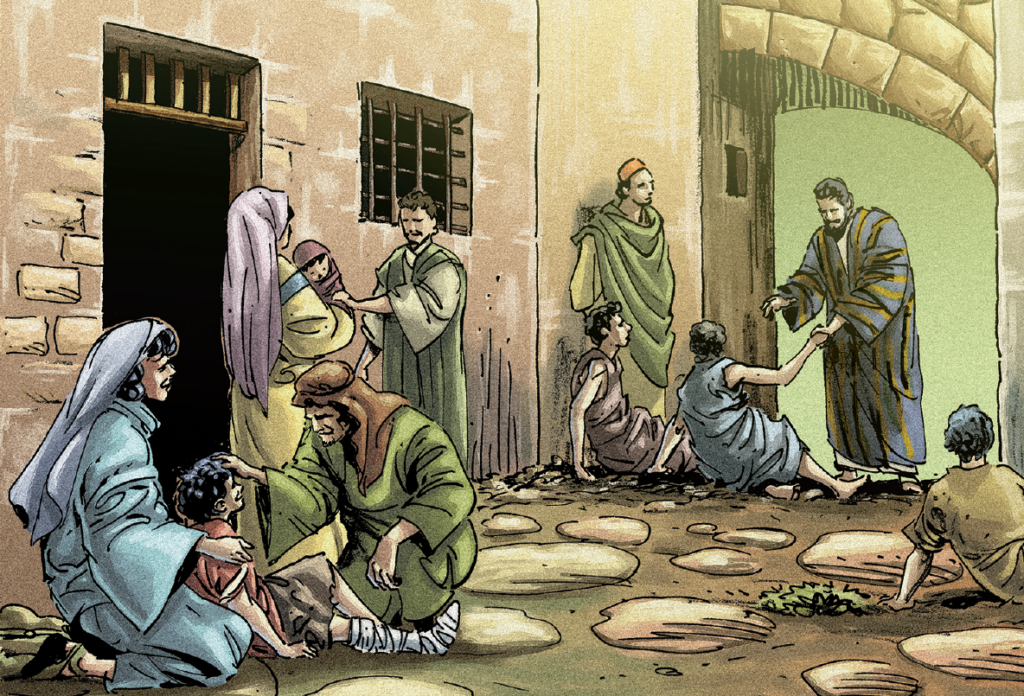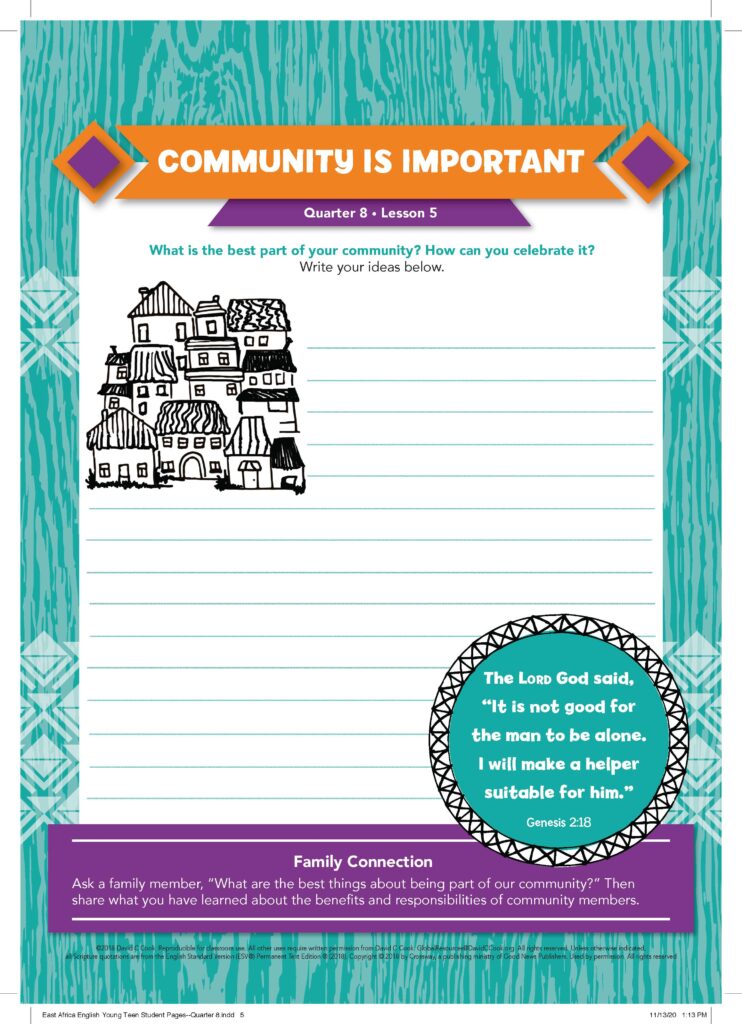During the lesson, the information for you to know is written in regular type, and what we suggest speaking or reading aloud to children is in bold. All resources for this lesson, including the Teacher Guide, Student Page, Family Connection Card, and other resources can be downloaded in a ZIP file by clicking on the following link:
In some lessons you will find "resource articles." These are articles written by experts from around the world to help equip you for your work with children and adolescents. Share them with parents or guardians if you consider it appropriate.
All the believers were together and had everything in common. They sold property and possessions to give to anyone who had need. Every day they continued to meet together in the temple courts. They broke bread in their homes and ate together with glad and sincere hearts, praising God and enjoying the favor of all the people. And the Lord added to their number daily those who were being saved.
Acts 2:44–47
As brothers and sisters in Christ, we are united in love and fellowship just as the believers were in the book of Acts. These believers enjoyed life together—as a community. As God’s love was seen in their sharing and joy, their numbers grew. What God was doing in the community was so beautiful that others were drawn to God.
God intends for us to be part of a community where we can be encouraged and challenged as we grow in faith. Consider how you are woven into your community. How can you serve with more joy? Encourage your church to reach out to others with God’s love. As you begin to understand true community, you will experience God’s love in new ways.
Encourage the students to ask their family members, “What do you like best about our community? What would you like to improve in our community?” They can then share what they have learned about the benefits of community and the responsibilities of community members.
Teacher Tip: If possible, email or text the Family Connection Card to the families of your students.
Make 2 lines on the ground about an arm’s length apart. The lines should be long enough so half the students can stand on each. Divide the class into 2 groups—1 of boys and 1 of girls. Have each group stand on 1 line, close enough that their shoulders are touching. Explain the rules of the game.
The teens standing on each line are team members. When I tell you to start, your team must rearrange the order of the line. The person who is at 1 end of the line will move to the other end. The second person will move to the second spot on the other end of the line. You can move around each other, but everyone on the team must keep 1 foot on the line at all times. If a person steps off the line, he must go to his original position in the line and start over again. The first team to successfully reverse the order of their line wins the game.
Give the students a few minutes to play the game. Congratulate the winning team, and have the class sit down for discussion.
Name a community to which you belong.
Some examples of communities are our families, our classmates, our church community, our village or town, and our nation. Some communities are organized groups where each member has a specific assigned task to complete. Some communities are less organized, such as a church community, where each person does what he or she can to help others. But all successful communities need certain things to work well together. We will learn about those today.
Everyone needs community. The Bible tells us that God did not intend for us to live alone. He created us to be in community. Listen to what God said after He created the very first man, Adam.
Have a student read Genesis 2:18 aloud from the Bible. If that is not possible, the verse is printed here.
If you are using the Memory Verse Poster, show it to the students.
The Lord God said, “It is not good for the man to be alone. I will make a helper suitable for him.”
Genesis 2:18

Why do you think God said it was not good for man to be alone?
We were made for community. From the very beginning, God created us to care for and serve others and to receive help and encouragement from those around us.
Optional: If you are using The NIV Action Study Bible, the teens can read about the early church in the “God in Action,” “People in Action,” and “Faith in Action” sections at the beginning of the book of Acts.
The early church can teach us a lot about living in a healthy community. Listen to a description of an early church community:
They devoted themselves to the apostles’ teaching and to fellowship, to the breaking of bread and to prayer. Everyone was filled with awe at the many wonders and signs performed by the apostles. All the believers were together and had everything in common. They sold property and possessions to give to anyone who had need. Every day they continued to meet together in the temple courts. They broke bread in their homes and ate together with glad and sincere hearts, praising God and enjoying the favor of all the people. And the Lord added to their number daily those who were being saved.
Acts 2:42–47
Allow 2–3 students to share their answers to each of the following questions.
Let’s read another Bible passage about the early church community.
Optional: If possible, share the image from The Action Bible.

All the believers were one in heart and mind. No one claimed that any of their possessions was their own, but they shared everything they had. With great power the apostles continued to testify to the resurrection of the Lord Jesus. And God’s grace was so powerfully at work in them all that there were no needy persons among them. For from time to time those who owned land or houses sold them, brought the money from the sales and put it at the apostles’ feet, and it was distributed to anyone who had need.
Acts 4:32–35
What new information did this passage give us about the early church community?
They were one in heart and mind, and they shared everything. None of them were needy, as they shared with those who had a need.
The early church community had a shared belief in Jesus. They learned together, spent time together, ate meals together, and encouraged each other. They worked together and helped each other. Each person contributed to the community and depended on the community. Let’s talk about some of the specific things they did that helped to make their community a healthy one.
In a healthy community, people build relationships.
Allow 2–3 teens to share their answers to each of the following questions.
How do you think the members of the early church community built relationships?
If the following ideas are not mentioned, share that the community spent time together, prayed together, worshipped together, and enjoyed fellowship together.
Is it important to build relationships in a community? Why or why not?
How do we build relationships in our community?
In a healthy community, people work together for the good of all and help those in need.
How did the early church community help to meet each other’s needs?
The believers sold their possessions and provided for one another.
Is it important for a community to help to meet each other’s needs? Why or why not?
The members of healthy communities also depend on one another.
How did the early church community depend on one another?
They shared responsibilities, and each member helped to meet the needs of all members.
Is it important for community members to depend on one another? Why or why not?
When community members are committed to one another, it allows them to build relationships and help each other in times of need.
Being part of a Christian community allows Christians to grow in their faith as they worship, study the Bible, and pray with one another. As we saw in the description of the early church community, God’s love among the believers made others want to know more about Him and His love. So, a strong Christian community can also draw others to God.
As you can see, communities provide many benefits for their members. And, as members of communities, we need to do what we can to make our communities healthier so that all of the members build relationships, work together to meet each other’s needs, depend on one another, and help each other to grow.
Optional: If you are using the Student Pages, give the teens time to complete the activity on their pages.

In the game we played earlier, we learned the importance of cooperating with and helping one another. In our community, we need each other. Let’s do an activity to show that. Line up in 2 groups. Each group should stand shoulder to shoulder, facing the other line.
Think of a benefit you gain from your community. As you think of something, reach out and take the hand of the person across from you.
What is a way you can help your community to become healthier? As you think of something, reach out your other hand and take the hand of the person across from you.
We are all connected, and we each have responsibilities to one another. When we fulfil these responsibilities, we make our community better.
The most meaningful connections are created in communities where people share something in common, especially their faith. With God’s help, we can learn to cooperate, work together, help one another, and resolve conflict respectfully and peacefully. Think about what you can do to fulfil your responsibilities as a member of your community.
Split into pairs with the person whose hands you are holding. If you want to, you can commit to pray for each other and ask God to help you do this. Ask God to help you to create a better community for yourself and that person. If you do not yet believe in God, you can talk together about ways to make the community better.
Give the students a few minutes to think and pray. Then close with a blessing based on Romans 12:16–18.
Blessing: May God help you love and respect others and serve them humbly as you live in harmony with those in your community. May you continue to treat others respectfully and resolve conflict peacefully to create a more God-honouring community.
Lead the children in singing this quarter’s song, if possible.
Life on Life ©2020 David C Cook. Reproducible for home or classroom use only. All other uses require written permission from David C Cook [email protected]. All rights reserved.